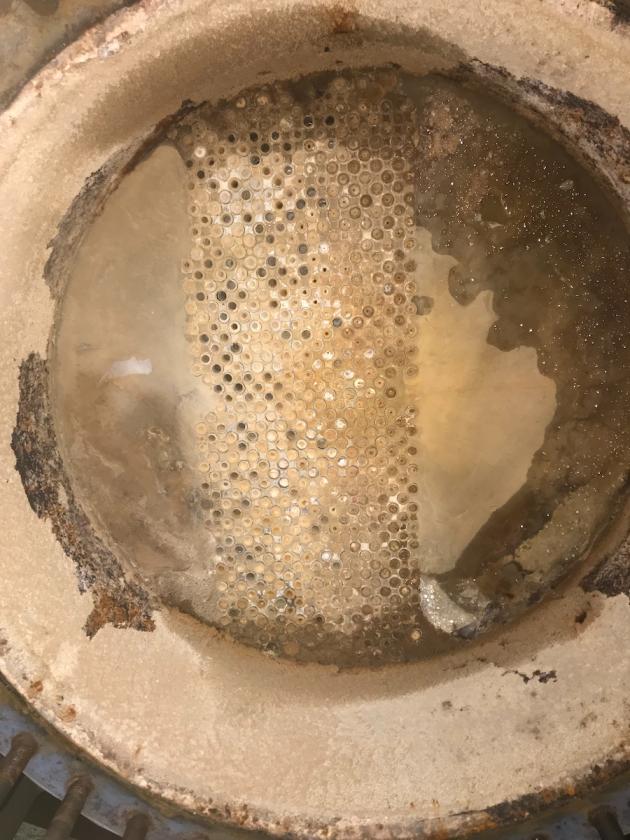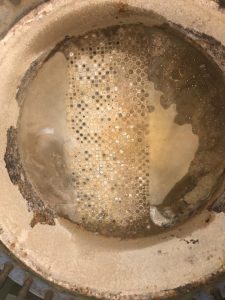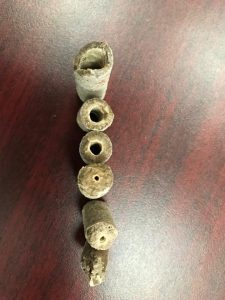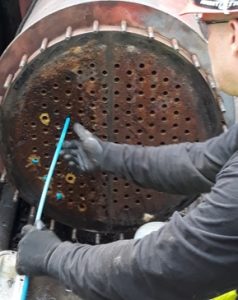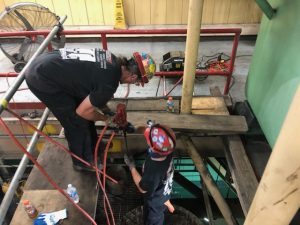Heat exchanger tube deposits can have a tremendous negative impact on the overall performance of the heat exchanger and the overall process the heat exchanger is incorporated in. Even thin amounts of hard deposits can be a detriment to performance and can be difficult to remove. What happens when your heat exchanger tubes are partially or fully blocked? How do you accomplish unclogging a blocked heat exchanger and then remove the remaining scale in order to bring the tube back to its base metal and the heat exchanger back to proper performance? These are the questions that this article will answer.
 Keep Heat Exchanger Tube Deposits to a Minimum
Keep Heat Exchanger Tube Deposits to a Minimum
Higher levels of tube deposits reduce heat transfer and negatively impact heat exchanger performance. The more deposit there is, the harder it becomes to remove. The lower cost, faster methods for removing tube deposits become unusable after the deposit surpasses a certain thickness threshold. When the tubes are partially blocked or blocked completely, shooting tube cleaners to scrape the deposit or using 20k water blasting becomes useless.
Obviously, it is best to avoid letting the heat exchanger tubes get to this condition through consistent and proper maintenance techniques like cleaning at scheduled intervals with lower-cost solutions such as shooting projectiles through the tubes. In some situations, this may not be possible such as if the unit is unable to be shut down frequently enough to adequately clean the tubes or if the process liquid flowing through the tubes is extremely prone to creating heavy amounts of deposits.
In situations like these, heat exchanger owners need to be mindful of how quickly their tubing becomes blocked. Having an understanding of how long it will take to unclog tubes will give owners a better idea of how long their system could be out of service.
Unclogging a Blocked Heat Exchanger
Cleaning partially or completely blocked heat exchanger tubes can be a big challenge. So much of the success of the cleaning has to do with the makeup of the deposit and how it reacts to the cleaning process. Heat exchanger owners typically are unable to accurately supply deposit composition information until the unit has been opened. This situation makes estimating production rates for cleaning very difficult.
It is usually common in situations like this for contractors to underestimate the actual cleaning time. It is best for both parties to understand that with cleaning blocked heat exchanger tubes that the unknown variables are higher than a standard cleaning job and this could lead to extended job times and cost overruns.
Projectile Cleaning Heat Exchangers
The method that Projectile uses for cleaning blocked and partially blocked heat exchanger tubes is a two-part method. First, the tubes are drilled with specialized heat exchanger drilling equipment. After the drilling is done, Metal Projectiles are used to remove the remaining scale from the tubes.
The reason the cleaning is done in two steps is that the drilling equipment is designed not to touch the tube wall. The specialized tube drill bit is sized about 0.010-0.030 inches under the inner diameter of the tube. Thus after the drilling, some deposit will still remain on the tube. The Metal Projectiles are then shot through the tubes with a low-pressure pumping system to scrape off the remaining deposits from the tube wall.
 Blocked Heat Exchanger Deposits
Blocked Heat Exchanger Deposits
The heat exchanger drilling equipment is not like normal drilling equipment as it is specially designed to drill tube deposits. The drill uses a geared air motor for extra torque. Air is the primary power as opposed to an electric source due to the hazardous environment heat exchangers can sometimes be found in. The tube cleaning drill also incorporates a water flush that carries water to the tip of the drill bit. The water is important for keeping the drill cooled and for removing drilled deposits so the bit can continue to drill through the scaling attached to the tube.
Two Types of Drills Used in Unclogging
The two heat exchanger drill types differ based on the shafting used: flexible shaft or solid shaft.
Flexible Shafts
Flexible shafts are easier to use and ideal for confined spaces like condensers because the shafting can bend into tight spaces. The downside of using a flexible shaft drill in unclogging a blocked heat exchanger is that it does not create as much torque and thus is not as effective at removing deposits. The flexible shaft is also much slower at removing tube deposits.
Solid Shafts
The solid shaft creates much more torque and can eat through tube deposits much faster. The drawback of using a solid shaft is that it makes drilling much more difficult and laborious. If the heat exchanger is 30 feet long, you need to assemble 30 feet of shafting and push the drill in and out of the tube the entire length. If there is not enough clearance for the shafting, then the operators need to assemble the shafting sections as they drill.
This process can be very time-consuming. In cases with completely blocked heat exchanger tubes, the flexible shafts are usually not as effective and thus the solid shaft method needs to be used. Each situation is different and the situation should dictate which drill type to use.
Drill Tips for Unclogging a Blocked Heat Exchanger
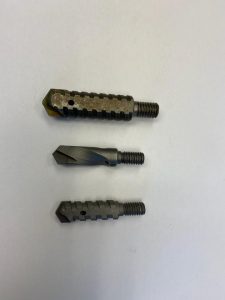
The last step in the process is shooting Metal Projectiles through the tubes. This last step will successfully remove the remaining deposit attached to the wall of the tubing that the drill bit left behind. This page on our website explains in detail how the projectile cleaning method works for removing the remaining deposits.
For more information on unclogging a blocked heat exchanger please contact us at:
+1 724-763-7633

